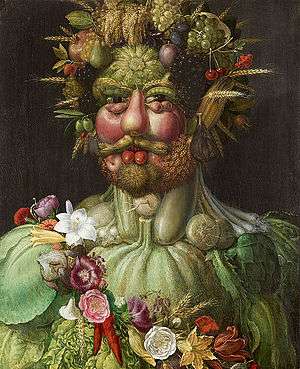Vertumnus (painting)
Vertumnus is a painting by Mannerist painter Giuseppe Arcimboldo produced in Milan c. 1590–1591. The painting is Arcimboldo's most famous work and is a portrait of the Holy Roman Emperor Rudolf II re-imagined as Vertumnus, the Roman god of metamorphoses in nature and in life. The fruits and vegetables symbolize the abundance of the Golden Age that has returned under the Emperor's rule.[1][2]

The painting is part of the collection at Skokloster Castle in Sweden.
Painting
The portrait of the emperor is created out of plants – flowers and fruits from all seasons: gourds, pears, apples, cherries, grapes, wheat, artichokes, beans, peapods, corns, onions, cabbage foils, cherries, chestnuts, figs, mulberries, grapes, plums, pomegranates, various pumpkin and olives. Rudolf's portrait, composed of fruit, vegetables, and flowers, symbolized the perfect balance and harmony with nature that his reign represented. These portraits were an expression of the Renaissance mind's fascination with riddles, puzzles, and the bizarre. Arcimboldo's traditional religious subjects were later forgotten, but his portraits of human heads composed of objects were greatly admired by his contemporaries.[3][4]
References
- "the-mannerist-style". www.artsconnected.org.
- "biography". www.giuseppe-arcimboldo.org.
- "Giuseppe Arcimboldo", SK Kloster Slott.se. Retrieved 5 April 2014.
- Rosenberg, Karen (September 23, 2010). "Several Obsessions, United on the Canvas". New York Times. Retrieved March 16, 2017.
External links
